PONTIAC GRAND-AM 1993 Workshop Manual
Manufacturer: PONTIAC, Model Year: 1993, Model line: GRAND-AM, Model: PONTIAC GRAND-AM 1993Pages: 306, PDF Size: 15.39 MB
Page 51 of 306
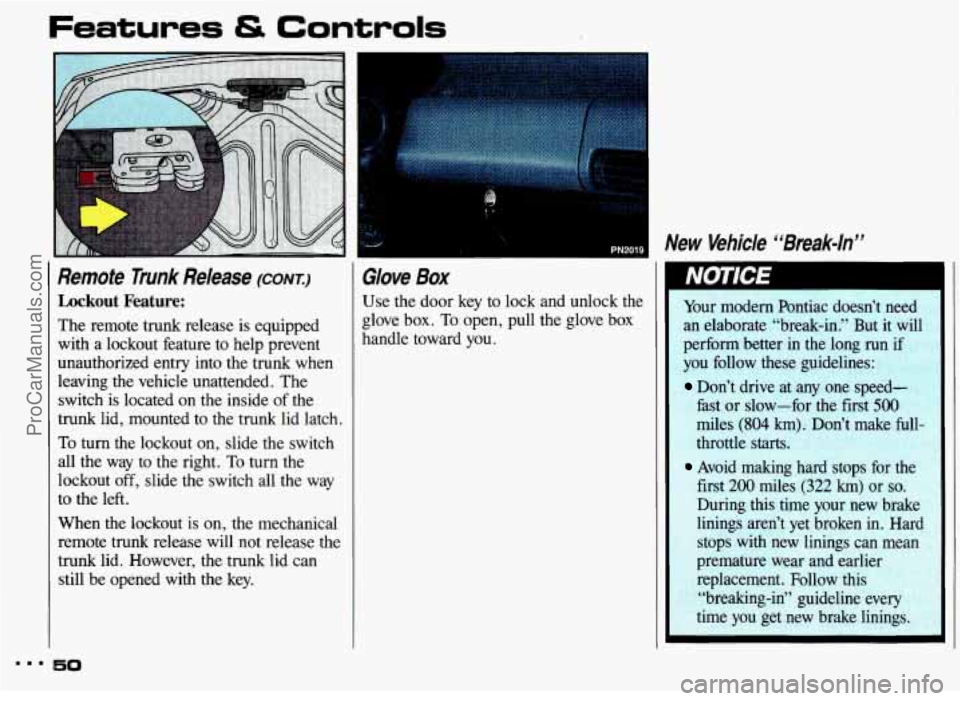
Features & Controls
Remote Trunk Release (CONK)
Lockout Feature:
The remote trunk release is equipped
with a lockout feature to help prevent
unauthorized entry into the trunk when
leaving the vehicle unattended. The
switch is located on the inside of the
trunk lid, mounted to the
trunk lid latch.
To turn the lockout on, slide the switch
all the way to the right.
To turn the
lockout off, slide the switch all the way
to the left.
When the lockout is on, the mechanical
remote trunk release will not release the
trunk lid. However, the trunk lid can
still be opened with the key.
Glove Box
Use the door key to lock and unlock the
glove box. To open, pull the glove box
handle toward you. Your
modern Pontiac doesn’t need
an elaborate “break-in.” But
it will
perform better in the long run if
you follow these guidelines:
Don’t drive at any one speed-
fast or slow-for the first 500
miles (804 km). Don’t make full-
throttle
starts
Avoid making hard st+ for the
first
200 miles (322 km) or so.
During this time your new brake
linings aren’t yet broken in. Hard stops with new linings can mean
premature wear and earlier
replacement. Follow this
“breaking-in” guideline every
time you get new brake linings
ProCarManuals.com
Page 52 of 306
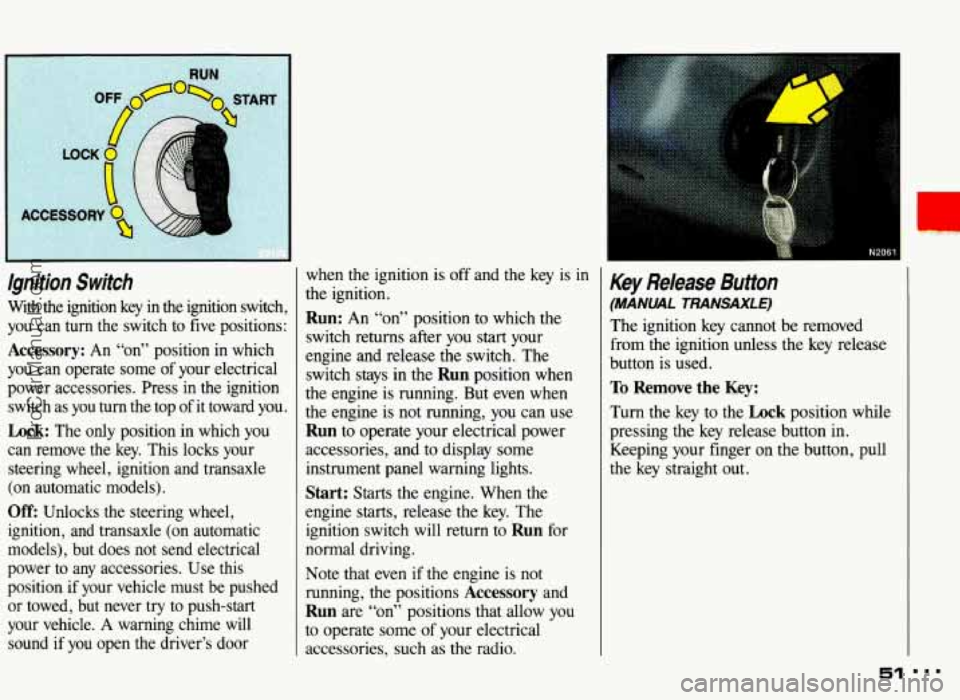
lgnition Switch
With the ignition key in the ignition switch,
you can turn the switch
to five positions:
Accessory: An “~n” position in which
you can operate some of your electrical
power accessories. Press in the ignition
switch as you turn the top of it toward you.
Lock: The only position in which you
can remove the key. This locks your
steering wheel, ignition and transaxle
(on automatic models).
Off: Unlocks the steering wheel,
ignition, and transaxle (on automatic
models), but does not send electrical
power to any accessories. Use this
position if your vehicle must be pushed
or towed, but never try to push-start
your vehicle.
A warning chime will
sound if
you open the driver’s door when
the ignition is
off and the key is in
the ignition.
Run: An “on” position to which the
switch returns after you
start your
engine and release the switch. The
switch stays in the
Run position when
the engine is running. But even when
the engine is not running,
you can use
Run to operate your electrical power
accessories, and
to display some
instrument panel warning lights.
Start: Starts the engine. When the
engine starts, release the key. The
ignition switch will return to
Run for
normal driving.
Note that even if the engine is not
running, the positions
Accessory and
Run are “on” positions that allow you
to operate some of your electrical
accessories, such
as the radio.
Key Release Button
(MANML TRANSAXLE)
The ignition key cannot be removed
from the ignition unless the key release
button is used.
To Remove the Key:
Turn the key to the Lock position while
pressing the key release button in.
Keeping your finger on the button, pull
the key straight out.
51 ...
ProCarManuals.com
Page 53 of 306

Features & Controls
On manual transaxle vehicles,
lock the steering column
and result
in a loss of ability to steer the
vehicle. This could cause a
collision.
If you need to turn the
engine
off while the vehicle is
moving,
turn the key only to Off.
Don’t press the key release button
while the vehicle is moving.
L turning the key to Lock will
... 52
NOTICE Starting Your Engine
Engines start differently. The 8th digit of
your Vehicle Identification Number
(VIN) shows the code letter or number
for your engine. You will find the
VIN
at the top left of your instrument panel.
(See the Index under @hide
IdentiJication Number.
) Follow the
proper steps to
start the engine.
ProCarManuals.com
Page 54 of 306

Automatic Tmnsaxle
Move your shift lever to P (Park) or
N (Neutral). Your engine won’t start in
any other position-that’s a safety
feature.
To restart when you’re already
moving, use
N (Neutral) only.
Don’t
try to shift to P (Park) if
5 your Pontiac is moving. If you do,
! you could damage the transaxle.
3 Shift to P (Park) only when your
vehicle is stopped.
8‘
Manual Tmnsaxle
Shift your gear selector to N (Neutral)
and hold the clutch pedal to the floor
while starting the engine. Your vehicle
won’t start
if the clutch pedal is not all
the way down-that’s a safety feature.
Both Tmnsax/es
To Start Your 2.3L Quad OHC or
Quad
4 Engine (Code 3, A or D):
1 , Don’t push the accelerator pedal
before starting your engine. In some
other vehicles you might need to do
this, but because of your vehicle’s
computer systems, you don’t.
2. Turn your ignition key to Start.
When the engine starts, let go of the
key. The idle speed will go down as
your engine gets warm.
3. If it doesn’t start right away, and the
weather is very cold (below
-20°F’ or
-29”C), push the accelerator pedal
about one-quarter of the way down
while you turn the key to
Start. Do
this until the engine starts. As soon as
it does, let go
of the key.
53
ProCarManuals.com
Page 55 of 306
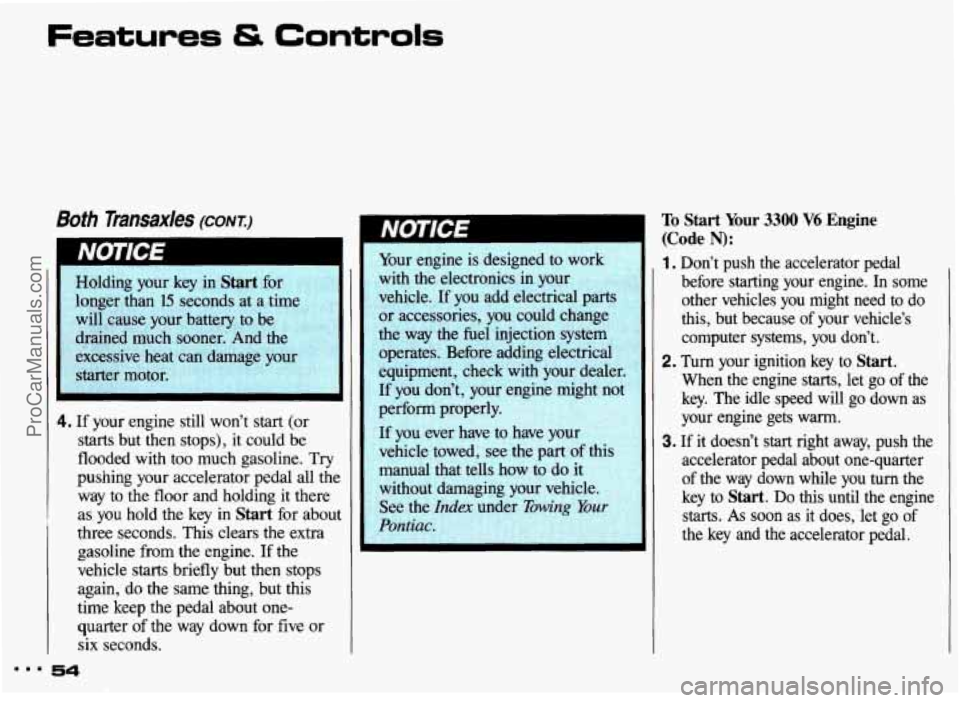
Features & Controls
Both Transax/es (CONTI
Holding your key in Start for
longer than
15 seconds at a time
will cause your battery
to be
drained much sooner. And the
excessive heat can damage your
starter motor.
4. If your engine still won’t start (or
starts but then stops), it could be
flooded with too much gasoline.
Try
pushing your accelerator pedal all tht
way to the floor and holding it there
as you hold the key in
Start for abou
three seconds. This clears
the extra
gasoline from the engine. If the
vehicle
starts briefly but then stops
again, do the same thing, but this
time keep the pedal about one-
quarter of the way down for five or
six seconds. Your
engine is designed to work
with the electronics in
your
vehicle. If you add electrical parts
or accessories, you could change
the way the
fuel injection system
operates. Before adding electrical
equipment, check with your dealer.
If
you don’t, your engine might not
perform properly.
If you ever have to have your
vehicle towed, see the part of this
manual that tells how to
do it
without damaging your vehicle. See the
Index under Towing Your
Pontiac.
To Start Your 3300 V6 Engine
(Code N):
1. Don’t push the accelerator pedal
before starting your engine. In some
other vehicles you might need to
do
this, but because of your vehicle’s
computer systems, you don’t.
2. Turn your ignition key to Start.
When the engine starts, let go of the
key. The idle speed will go down as
your engine gets warm.
3. If it doesn’t start right away, push the accelerator pedal about one-quarter of the way down while you
turn the
key to
Start. Do this until the engine
starts.
As soon as it does, let go of
the key and the accelerator pedal.
m.. 54
ProCarManuals.com
Page 56 of 306
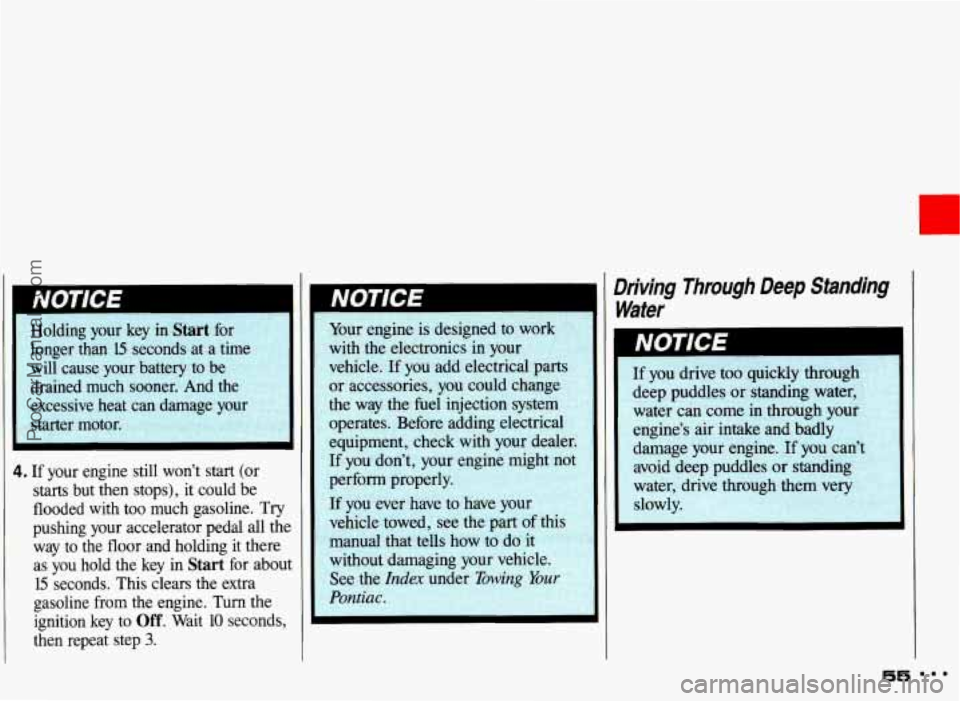
NOTICE
Holding your key in Start for
longer than
15 seconds at a time
will cause your battery to be
drained much sooner. And the excessive heat can damage your starter motor.
4. If your engine still won’t start (or
starts but then stops), it could be
flooded
with too much gasoline. Try
pushing your accelerator pedal all thl
way to the floor and holding
it there
as you hold the key
in Start for abou
15 seconds. This clears the extra
gasoline from the engine.
Turn the
ignition key to
Off. Wait 10 seconds:
then repeat step
3.
1lL
Your engine is designed to work
with the electronics in your
vehicle.
If you add electrical parts
or accessories, you could change
the way the fuel injection system
operates. Before adding electrical
equipment, check with your dealer.
If you don’t, your engine might not
perform properly.
If you ever have to have your
vehicle towed, see the part of this
manual that tells how to do it
without damaging your vehicle.
See the
Index under Towing bur
Pontiac.
Triving Through Deep Standing
Vater
NOTICE I
If you drive too quickly through
deep puddles or standing water,
water can come in through your
engine’s air intake and badly
damage your engine. If you can’t
avoid deep puddles or standing
water, drive through them very
slowly.
5E ...
ProCarManuals.com
Page 57 of 306

Features & Controls
Engine Block Heater (oPnoN)
In very cold weather, 0" F (-18" C) or
colder, the engine block heater can help.
You'll get easier starting and better fuel
economy during engine warm-up.
To Use the Block Heater:
1. Turn off the engine.
2. Open the hood and unwrap the
3. Plug it into a normal, grounded
electrical
cord.
110-volt outlet. Plugging the cord into an
ungrounded outlet could cause
an electrical shock. Also, the
wrong kind of extension cord
could overheat and cause a fire.
You could be seriously injured.
1
Plug the cord into a properly
grounded three-prong 110-volt
outlet.
If the cord won't reach, use
a heavy-duty three-prong extension
cord rated for at least
15 amps.
I NOTICE
After you've used the block heater, , ;
be sure to store the cord as it was., ,(
moving engine parts. If you don't,
.. before, to keep it away from ,~
it could be damaged, ~".',:; ,"::,:;s ':,:';:::':;
How long should you keep the block
heater plugged in? The answer depends
on the weather, the kind
of oil you have,
and some other things. Instead of trying
to list everything here, we ask that you contact a Pontiac dealer in the area
where you'll be parking your vehicle.
The dealer can give you the best advice
for that particular area.
mmm 56
ProCarManuals.com
Page 58 of 306

Shifting the Automatic Transaxle
Your automatic transaxle has a shift
lever located on the console between the
seats.
There are several different positions for
your shift lever. In this manual, these
are referred
to by the commonly used
symbols in the right column below:
Park P
Reverse R
Neutral N
Drive D
Second 2
First 1
Park
P (hrk): This locks your front wheels.
It’s the best position to use when you
start your engine because your vehicle
can’t move easily.
I I
It can be dangerous to get out
b of your vehicle if the shift
hever is not fully in
P (Park) with
the parking brake firmly
set v-*7
vehicle can roll
Don’t leave your venue
WI I me
engine is running unless you llavr
to. If you have left the engine
running, the vehicle can move
suddenly. You or others could be
injured. To be sure your vehicle
won’t move, when you’re on fair1
level ground, always set your
parking brake and move the shift
lever to
P (Park). See the Index
under Shifting into P (Park). If you
are parking
on a hill, or if you’re
pulling a trailer, also see the
Index
under Parking on Hills or %wing a
Trailer.
ProCarManuals.com
Page 59 of 306
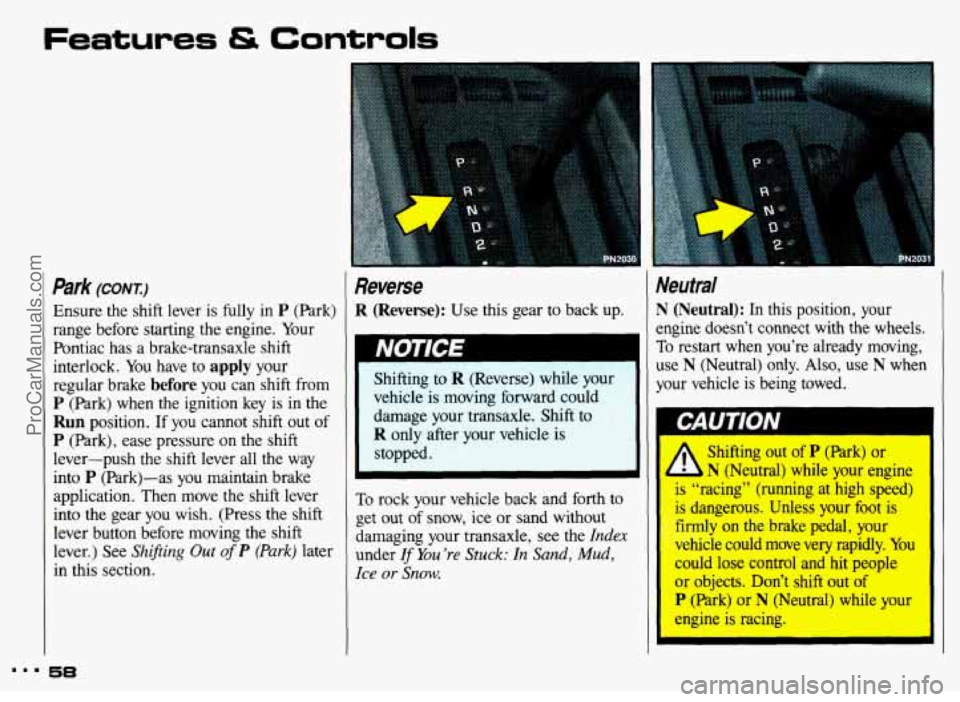
Features & Controls
Park (CONT.)
Ensure the shift lever is fully in P (Park)
range before starting the engine. Your
Pontiac has a brake-transaxle shift
interlock. You have
to apply your
regular brake
before you can shift from
P (Park) when the ignition key is in the
Run position. If you cannot shift out of
P (Park), ease pressure on the shift
lever-push the shift lever all the way
into
P (Park)-as you maintain brake
application. Then move the shift lever
into the gear you wish. (Press the shift
lever button before moving the shift
lever,) See
Shifting Out of P (Park) later
in this section.
Reverse
R (Reverse): Use this gear to back up.
Shifting to
R (Reverse) while your
vehicle
is moving forward could
damage your transaxle. Shift
to
R only after your vehicle is
stopped.
To rock your vehicle back and forth to
get out of
snow, ice or sand without
damaging your transaxle,
see the Index
under If You ’re Stuck: In Sand, Mud,
Ice or Snow.
Neutral
N (Neutral): In this position, your
engine doesn’t connect with the wheels.
To restart when you’re already moving,
use
N (Neutral) only. Also, use N when
your vehicle is being towed.
A Shifting out of P (Park) or
1 N (Neutral) while your engine I
‘racing” (running at high speed)
is dangerous. Unless your foot is
firmly on the brake pedal, your
vehicle could move very rapidly. You
could lose control and hit people
or objects. Don’t shift out
of
P (Park) or N (Neutral) while your
engine is racing.
I.. 58
ProCarManuals.com
Page 60 of 306
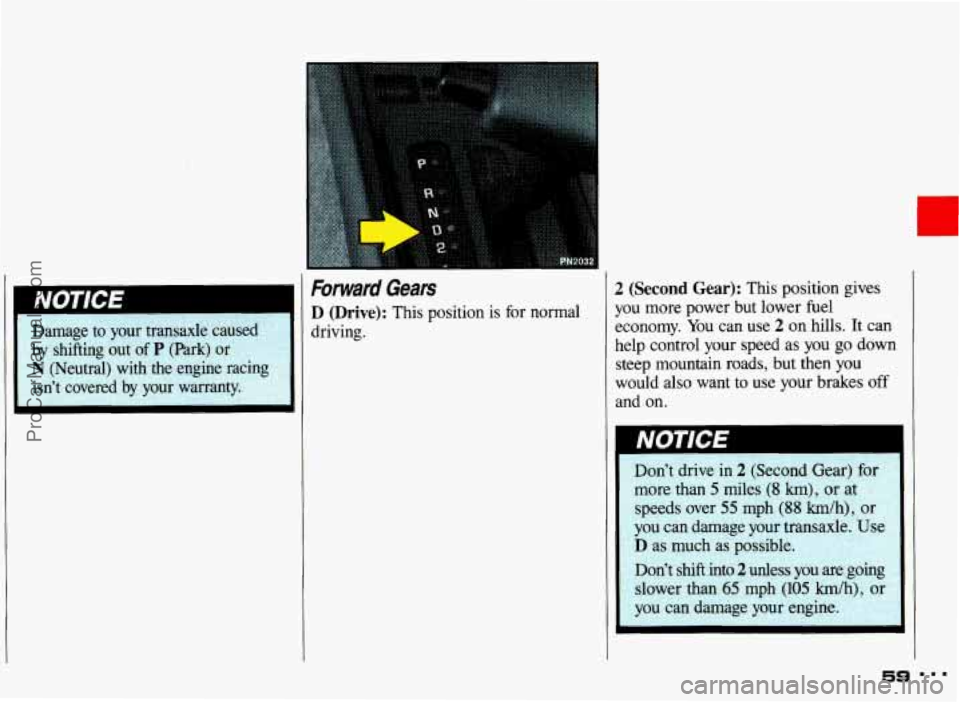
Forwad Gears
D (Drive): This position is for normal
driving.
2
Y(
e(
hc
st
a1
W
b
(Second Gear): This position gives
IU more power but lower fuel
:onomy. You can use 2 on hills. It can
:lp control your speed as you go down
eep mountain roads, but then
you
rould also want to use your brakes off
Id on.
59 ...
ProCarManuals.com